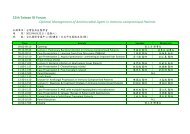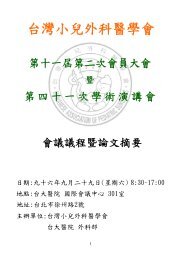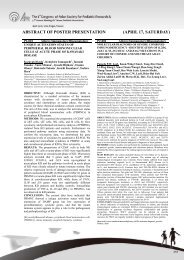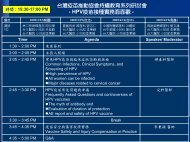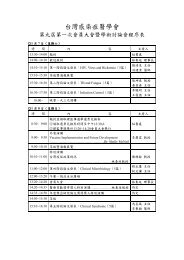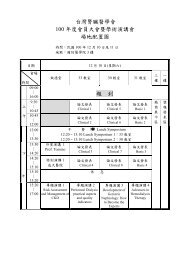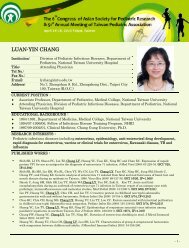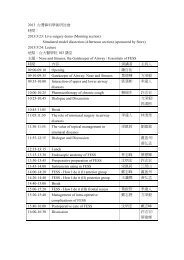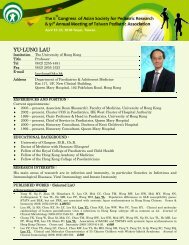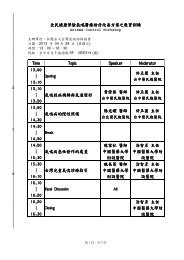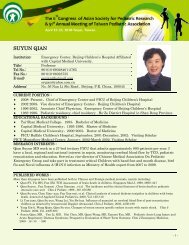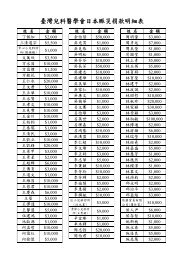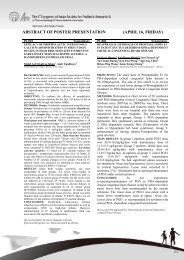FP7-05THE INCIDENCE <strong>AND</strong> PROGNOSIS <strong>OF</strong>CONGENITAL CYTOMEGALOVIRUS INFECTIONIN JAPAN <strong>AND</strong> VIETNAMMasami Miyakawa 1 , Michiko Doi 1 , Hideki Motomura 1 ,Masako Moriuchi 1 ,Hiroshi Yoshino 2 , LayMyint Yoshida 2 ,Koya Ariyoshi 2 , Le H. Tho 3 , Dang Duc Anh 4 , Naoki Inoue 5 ,Hiroyuki, Moriuchi 11 Dept of Mol Microbiol Immunol, Grad Sch of Biomed Sci, NagasakiUniversity; 2 Dept of Clin Med, Inst of Trop Med, Nagasaki University;3 Khanh Hoa Provincial Public Health Service, Vietnam; 4 National Instituteof Hygiene and Epidemiology, Vietnam; 5 National Institute of InfectiousDiseases, Japan.Congenital cytomegalovirus (CMV) infection leads to variousclinical manifestations and outcomes, thus the influence on thepublic health and socioeconomic burden can be significant. Itsepidemiological features are diversified by environmental andsocioeconomic factors. It has been recognized as one of the mostimportant congenital infections and a leading cause of congenitalcentral nervous system disorders in developed countries; however,its epidemiological and clinical characteristics in Asian countriesremain obscure.We have been conducting congenital CMV infectionmass-screening projects in Japan and Vietnam, two Asiancountries that differ in environmental and socioeconomic features.In Japan, a pilot study aimed for the establishment of a nationaluniversal screening of neonates for congenital CMV infection hasbeen conducted in 6 prefectures including Nagasaki where CMVseroprevalence in pregnant women was 87.5%. Urine sampleshave been collected in filter paper during the first week after birth,and subjected to real-time PCR for CMV-DNA. A total of 2862samples have been tested in Nagasaki as of January 5 in 2010, and8 infants (0.28%) were positive. One infant presented withhydrocephalus, intrauterine growth retardation, sensorineuralhearing loss and thrombocytopenia at birth and his psychomotordevelopment has been moderately delayed as of 10 months of age.Another infant was asymptomatic at birth, but developed Westsyndrome at 7 months of age. Other 6 infants have beenasymptomatic, although mild liver dysfunction has beendemonstrated in two and transient neutropenia was observed inone infant.In Nha Trang, Vietnam, a birth cohort study is in progress: a totalof 2000 infants born at Khanh Hoa General Hospital are to bescreened for several congenital pathogens including CMV.Precedently, we conducted a pilot study in this area in 2007, andinvestigated 222 pairs of maternal and cord specimens for theprevalence of CMV infection. We have demonstrated andpresented in the previous congress that maternal seroprevalencewas 100%, and two infants (0.9%) were CMV-DNA positive.CMV-IgG avidity rates of their mothers were high (68% and69%), suggesting reinfection. Those two infants had negativeCMV-IgM and were asymptomatic at birth; however, a detailedfollow-up study wasn’t conducted.FP7-06INTRODUCTION <strong>OF</strong> A SINGLE AMINO ACIDMUTATION IN ENTEROVIRUS 71 2B PROTEINRESULTS IN DEFECTIVE VIRALREPLICATION –A NEW PARADIGM <strong>OF</strong> HOSTCELL APOPTOSIS MODULATION BY A VIRUSChun-Yi Lu, Hsiu-Ming Shih*, Wei-ting Liu, Yi-Ting Tsai,Luan-Yin Chang, Li-Min HuangDepartment of Pediatrics, National Taiwan University Hospital, Taipei, Taiwan;*Institute of Biomedical Sciences, Academia Sinica, Taipei, TaiwanOBJECTIVE: Enterovirus 71 (EV71) is one of the mostimportant viruses causing central nervous system infections inchildren in the post-polio era. The 2B protein of enterovirusesis highly conserved in evolution, suggesting its important rolein enterovirus replication. The current study was aimed todisclose the roles of 2B in EV71 replication.METHODS: The 2B sequences of various enterovirusesincluding EV71 were analyzed. Protein-protein interactionswere determined by co-immunoprecipitation. By using reversegenetic technologies, infectious cDNA clones of EV71 wereestablished. Infectious clones with various 2B mutants werecreated by site-directed mutagenesis. The production ofwild-type EV71 and various mutants were determined byimmunofluorescence assay. Cellular apoptosis was assayed byusing Annexin V staining determined with flowcytometry.RESULTS: A reversed Bcl-2 homology domain 3 (BH3)-likesequence over the N-terminus of EV71 2B was identified.Co-immunoprecipitation experiments confirmed 2B competeswith MULE, a Mcl-1 E3 ligase, in Mcl-1 binding. Severalamino acids in the BH3-like domain of 2B were determined tobe the interacting points. Binding of 2B at Mcl-1 BH3 domainresulted in decreased Mcl-1 ubiquitination and degradation.The host cell apoptosis was in turn increased. In the infectiousclone system, introducing a single amino acid atMcl-1-interacting points at 2B was sufficient to reduce thevirus production in cell cultures. Introducing of multiple aminoacid mutations in this area makes the virus totally unable toreproduce in cells. Over-expression of EV71 2B rescued thereplication-defective viruses.CONCLUSIONS: Our study provides a new paradigm bywhich a virus modulates host cell apoptosis. Stabilization ofMcl-1 by EV71 2B prevents host cells from early apoptosisand provides sufficient time for EV71 replication. Targeting2B-Mlc-1 binding is a potential novel therapeutic strategy. Inaddition, the 2B-mutated and hence replication-defectivemutant viruses are potential vaccine candidates.[Keywords] Enterovirus 71, 2B, replication, ubiquitinationIn this congress, we will present interim reports of the twoongoing studies in Japan and Vietnam and discuss possibleimpacts of congenital CMV infection on these two Asiancountries. We thank K. Fujieda and others (Congenital CMVInfection Study Group) and obstetric staffs in both countries whocollected neonatal samples.[Keywords]Congenital Cytomegalovirus infection, Japan and Vietnam,mass-screening program, real-time PCR, prognosis83
FP7-07CAN BOVINE LACT<strong>OF</strong>ERRIN-CONTAININGPRODUCTS PROTECT CHILDREN FROMNOROVIRUS OUTBREAK?Hiroyuki Moriuchi , Masanori Egashira, MasakoMoriuchiDepartment of Pediatrics, Nagasaki University Hospital, Nagasaki, Japan;Department of Molecular Microbiology and Immunology, NagasakiUniversity Graduate School of Biomedical Sciences, Nagasaki, Japan.BACKGROUND: Norovirus is an important cause ofacute gastroenteritis worldwide, and its outbreaks amonginstitutionalized adults or children have accumulated in thepast years. Nevertheless, no specific preventive ortherapeutic agent has been available yet. Lactoferrin (LF),a milk-derived glycoprotein with a number of biologicalactivities, has recently been reported to have anti-noroviruseffect in vitro. We have recently reported that daily intakeof bovine LF (bLF) reduced the severity of rotavirusgastroenteritis in children; however, its effect on norovirusgastroenteritis remains unknown.OBJECTIVE: To investigate if bLF could protect healthychildren against norovirus gastroenteritis.DESIGN/METHODS: Healthy children (less than 5 yearsold) attending day-care centers (DCC) were randomlydivided into two groups: L group assigned to take 400 mgof bLF daily for 16 weeks and N group assigned not totake LF-containing products. Guardians were asked torecord clinical symptoms and signs on a daily basis duringthe study period. Feces were collected from all childrenwith acute gastroenteritis, and tested for rotavirus withimmunochromatographic assays (ICA) and norovirus withICA and real-time RT-PCR.RESULTS: A total of 91 children (46 in L group and 45 inN group) were analyzed for the incidence of gastroenteritiscaused by rotavirus or norovirus. Two in L group and nonein N group developed mild rotavirus gastroenteritis duringthe study period. Based on ICA, 2 (4.3%) in L group and 7(15.6%) in N group developed norovirus gastroenteritis (p< 0.01). Norovirus real-time RT-PCR revealed 2 patients(4.3%) in L group and 9 (20%) in N group, consisting of 5in GI genotype and 6 in GII genotype.CONCLUSIONS: Daily intake of bLF products reducedthe incidence of norovirus gastroenteritis in healthychildren attending DCC. Taken together with our previousstudy, LF appears to protect healthy children from viralgastroenteritis. Real-time RT-PCR had better sensitivitythan ICA, and was capable of genotyping.[Keywords] norovirus, gastroenteritis, lactoferrin, day care centerFP8-01HERG GENE MUTATIONS ORPOLYMORPHISMS IN PATIENTS WITHREPAIRED TETRALOGY <strong>OF</strong> FALLOT: APOTENTIAL RISK FOR VENTRICULARARRHYTHMIASShuenn-Nan Chiu, M.D 1 , Ming-Tai Lin, M.D 1 , Mei-HwanWu, M.D, PhD, FHRS 1 , Chien-Chih Chang, M.D 1 ,Hue-Wen Hsu, M.D 1 , Jou-Kou Wang, M.D, PhD 1 ,Chun-An Chen, M.D 1 , Ching-Tsuen Shen, M.D, PhD 2 ,Olivier Thériault, PhD 3 , Mohamed Chahine, PhD 31 Department of Pediatrics, National Taiwan University Hospital and College ofMedicine, National Taiwan University, Taipei, Taiwan; 2 Department ofPediatrics, Cathay General Hospital, Taipei, Taiwan; 3 Hôpital Laval, ResearchCentre, Sainte-Foy, Quebec, Canada, G1V 4G5, and Department of Medicine,Université Laval, Quebec City, Quebec, Canada, G1K 7P4BACKGROUND: hERG gene mutations/polymorphisms areassociated with congenital and acquired long QT syndrome.However, the effects of these changes on the repolarizationabnormality, secondary to complete right bundle branch block,in repaired Tetralogy of Fallot (T<strong>OF</strong>) patients are stillunknown. This study sought to define the role of hERG genemutations in ventricular arrhythmias in these patients.METHODS <strong>AND</strong> RESULTS: We analyzed the mutations orsingle nucleotide polymorphisms (SNPs) in all exons of thehERG gene in 83 patients with repaired T<strong>OF</strong> and completedhemodynamic and electrocardiographic data. Additionally, invitro biophysical characterization of mutant alleles wasperformed using whole-cell voltage clamp after expression inXenopus oocytes. Two novel mutations (p.M645R and p.R92C,one in each) and one non-synonymous SNP (p.K897T, threepatients) were found in five (6.0%) patients. Life-threateningevents occurred in six patients and were more common in thosewith genetic variants (2/5 vs. 4/78, p=0.040). The patient withp.M645R mutation experienced cardiac arrest two years aftercardiac repair. One patient with p.K897T SNP died suddenly35 years after cardiac repair. Expression of the p.M645Rmutant allele alone in Xenopus oocytes resulted in no currentgeneration while co-expression of the mutant and wild-typealleles showed a net decrease in I Kr .CONCLUSION: In patients with T<strong>OF</strong>, the coexisting hERGmutations and non-synonymous SNP might have additiveeffects on the repolarization abnormality from right bundlebranch block after cardiac repair and may potentially increasethe risks of ventricular arrhythmias in repaired T<strong>OF</strong> patients.[Keywords]hERG gene, mutation, Tetralogy of Fallot, ventriculararrhythmia, complete right bundle branch block84



